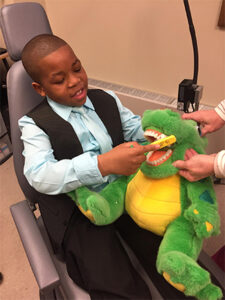
Onsite Dental Clinics Get Kids Needed Dental Care
The New Haven Public Schools district in Connecticut may have landed on a solution to ensuring kids in underserved communities receive the quality dental care they need, and attend class. The answer: bring the services to them.

Students enrolled in the New Haven Public Schools’ Smile New Haven program have access to affordable dental care services on their school campus in school-based health centers. The idea to add dental care to the district’s suite of services—medical and mental health—began 4 years ago when Sue Peters, APRN, MPH, director of School Health Centers at New Haven Public Schools, realized students’ need for dental services while working as a nurse practitioner. She would refer students to dentists for oral abscesses, caries and other treatments. “I would see them at the tail end when they would have to be treated, and the decay and lack of care I saw was astonishing,” she says.
Peters toured one of the 27 Hartford Public School’s Dental Program clinics to learn more about the services offered to students. In 2014, the first New Haven Public Schools dental clinic was established in the district’s School Health Centers. There are currently 17 health centers, with nine offering oral health services.
Onsite care provides students with much-needed access to care, and allows both students and parents to form a trusted relationship with onsite oral health professionals. It also helps the district address chronic absences. “With health issues being a leading reason why kids miss school, it makes sense that our health team become involved in helping to reduce these absences,” says Peters.
So far, the district has seen a drop in chronic absences. The Connecticut State Department of Education reports that of the district’s 21,981 students, 18.3% were chronically absent during the 2016–2017 school year—a drop from 2015–2016’s rate of 19.9%.

“We have definitely made a huge difference,” says Tracey Oberg, RDH, BDS, lead dental hygienist at New Haven Public Schools. “Some of these kids had never had a toothbrush before and many students were not getting treatment. Now, they are using our services, getting referred, and going outside the school and continuing treatment.”
Once parents submit a dental permission form, Oberg and Elicia Lupoli, RDH, deliver a range of preventive care services, including prophylaxis, sealants, X-rays, oral health education, and fluoride treatments during a 15- to 20-minute visit to ensure class time is not disrupted. Pre-K through 8th grade students also receives dental screenings, which allows clinicians to target students who present with infections and other oral conditions.

Once an X-ray is taken and entered into the system, Richard Delvecchio, DDS, the program’s dental director, interprets the radiographs remotely and enters individualized treatment plans into the system, which is then provided to the student to take home to the parent. For students in need of restorations, Delvecchio provides care onsite every other week, or the child can receive treatment at their dental home.
To date, officials estimate the program has provided 3,000 prophylaxis appointments, 1,210 sealant treatments, and 2,080 screenings. And the district intends to do more as the clinics hope to incorporate silver diamine fluoride to its service offerings. Delvecchio may also begin providing extractions. Eligible insurance is billed, but students are not turned away if they don’t have insurance.
Educating students—and parents—about oral self-care is also part of the dental hygienists’ daily interactions with students. Classroom presentations on toothbrushing and the importance of selecting healthy foods are made to the lower grades, while lessons on prevention and strategies for tobacco cessation are delivered to students in the higher levels.
“A lot of these students have never been to the dentist,” notes Peters. “Here at school, they are getting oral health care and oral health education. This program has increased awareness and access to dental services.”
Featured image by ZELJKOSANTRAC/ROYALTY-FREE E+


